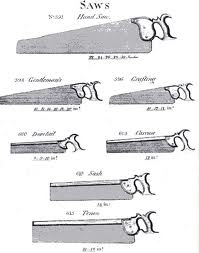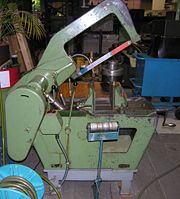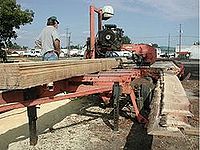Difference between revisions of "Saws"
(Created page with "Category:Particle Size Reduction{{Knoppen}} <noinclude><!------------------------------------------------ * READ THIS FIRST * Only edit this page if you can improve the ...") |
PurplePen19 (talk | contribs) |
||
| Line 6: | Line 6: | ||
* Please do not edit the sponsored link on the top right corner. | * Please do not edit the sponsored link on the top right corner. | ||
* Please start editing this page after the /noinclude | * Please start editing this page after the /noinclude | ||
* -------------------------------------------------></noinclude> | * -------------------------------------------------></noinclude> | ||
This | |||
[[File:Saws_1.jpg|thumb|200px|right|Saws - Hand Saw]] | |||
[[File:Saws_2.jpg|thumb|200px|right|Saws - Reciprocating]] | |||
[[File:Saws_3.jpg|thumb|200px|right|Saws - Mechanically operated]] | |||
'''Saws''' are any of various tools, either hand-operated or power-driven, having a thin metal blade or disk with a sharp, usually toothed edge, used for cutting wood, metal, or other hard materials. | |||
==Types== | |||
===Hand saws=== | |||
Hand-powered saws fall into three divisions, which are defined by the way they hold the blade stiff (a requirement to get an even, clean cut). | |||
A Hand saw uses either simply a blade thick enough to be stiff, or cuts on the pull stroke which reduces the stiffness requirement. This division includes the following specific types of saws: | |||
*Crosscut saw, for making cuts perpendicular to the grain | |||
*Rip saw, for cutting along the grain | |||
*Two-man saw, for cutting large logs or trees | |||
*Plywood saw, fine-toothed blade to reduce tearing of plywood | |||
*Veneer saw, two edged saw with fine teeth used to cut veneer | |||
*Hacksaw, fine-toothed tempered blade under tension for cutting metal, bone, and other hard materials. | |||
Although their use is dwindling the jigsaw and sabre saw (unpowered tools) may also refer to blade style saws. | |||
===Mechanically powered saws=== | |||
Mechanically powered saws mechanically move the teeth past the wood while the saw itself is held stationary. This is accomplished in one of three ways: the teeth are along the perimeter of a flat, circular blade; the blade reciprocates up and down rapidly; or the teeth are along one edge of a continuous band. | |||
===Reciprocating saw=== | |||
Reciprocating saw or sabre saw action similar to a jigsaw, but much larger, more powerful and with a longer stroke with the blade parallel to the barrel. Normally held in both hands, useful for demolition work or for cutting pipe. Sometimes powered by compressed air. | |||
==Videos== | |||
<youtube>yJz41jv_-Xg</youtube> | |||
<youtube>tYdGlwP3R6o</youtube> | |||
Latest revision as of 09:13, 15 October 2012
Saws are any of various tools, either hand-operated or power-driven, having a thin metal blade or disk with a sharp, usually toothed edge, used for cutting wood, metal, or other hard materials.
Types
Hand saws
Hand-powered saws fall into three divisions, which are defined by the way they hold the blade stiff (a requirement to get an even, clean cut).
A Hand saw uses either simply a blade thick enough to be stiff, or cuts on the pull stroke which reduces the stiffness requirement. This division includes the following specific types of saws:
- Crosscut saw, for making cuts perpendicular to the grain
- Rip saw, for cutting along the grain
- Two-man saw, for cutting large logs or trees
- Plywood saw, fine-toothed blade to reduce tearing of plywood
- Veneer saw, two edged saw with fine teeth used to cut veneer
- Hacksaw, fine-toothed tempered blade under tension for cutting metal, bone, and other hard materials.
Although their use is dwindling the jigsaw and sabre saw (unpowered tools) may also refer to blade style saws.
Mechanically powered saws
Mechanically powered saws mechanically move the teeth past the wood while the saw itself is held stationary. This is accomplished in one of three ways: the teeth are along the perimeter of a flat, circular blade; the blade reciprocates up and down rapidly; or the teeth are along one edge of a continuous band.
Reciprocating saw
Reciprocating saw or sabre saw action similar to a jigsaw, but much larger, more powerful and with a longer stroke with the blade parallel to the barrel. Normally held in both hands, useful for demolition work or for cutting pipe. Sometimes powered by compressed air.
Videos


